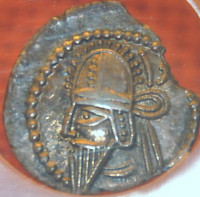Vologases VI
Vologases VI: Arsacid king of the Parthian Empire (r.208-226?).

In the first half of the second century, the Parthian Empire had been divided, but king Vologases IV had reunited it and even increased its influence in Armenia, where he had managed to get his son Vologases V appointed. In the year 180, this younger Vologases succeeded his father as king of Parthia.
All seemed well, but after several years, Vologases V backed the wrong horse in a Roman civil war: his ally Pescennius Niger was defeated by the emperor Septimius Severus (194) and the Romans declared war. In 195, they conquered Nisibis and Edessa, including them in a new Roman province, Mesopotamia. Two years later, Severus captured the twin cities of Seleucia and Ctesiphon, the capitals of the Parthian Empire.
Parthia was seriously weakened. When Vologases V died in 208, he was succeeded by his son Vologases VI, who would be the uncontested ruler until another Roman intervention, in 216, by the emperor Caracalla. Although the Parthians managed to survive this crisis as well, another son of Vologases V, Artabanus IV, had already revolted.
It seems that this revolt had started in 214 (and it is possible that this was the opportunity Caracalla had been looking for). When Caracalla arrived on the scene, Artabanus controled the eastern provinces and Susa, while Vologases VI still held the capital cities, Ctesiphon and Seleucia on the Tigris. In 216, Caracalla ordered the annexation of two buffer states, Edessa and Armenia, to improve the Roman positions before the war was to start. The Armenians refused to come to terms, but Edessa surrendered and offered hospitality to the emperor.
At this point, Vologases disappears from our sources: Caracalla was now doing business with Artabanus, who was unable to defend Adiabene, but was ready to fight in 217, when Caracalla had been assassinated and succeeded by Macrinus. Artabanus defeated Macrinus near Nisibis and concluded an armistice. The Romans agreed to pay an indemnity, the war was over, and the two leaders could concentrate upon other things. After all, Macrinus still had to consolidate his power, and Artabanus was involved in a civil war with Vologases.
Still, few observers will have failed to recognize that Parthian power was seriously weakened. A few years later, in 224, one of the subject nations in the Parthian Empire, the Persians, revolted. Their leader was a man named Ardašir, the founder of the Sasanian Dynasty. He defeated Artabanus in 224 and captured the cities of Vologases VI, Seleucia and Ctesiphon, in the year 226. The Parthian Empire, which had existed for more than four centuries, had come to an end.
Note
The chronology of the Arsacid kings of the Parthian Empire is less well-understood than, for example, the sequence of Seleucid and Ptolemaic kings or the emperors of Rome. This information is based on the researches by G.R.F. Assar, as published in "Iran under the Arsakids, 247 BC – AD 224/227" in: Numismatic Art of Persia (2011).